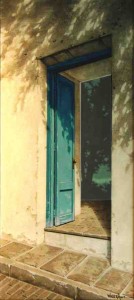Review by Ed Quillen
Ranching – August 2008 – Colorado Central Magazine
The Ranching Way of Life – San Luis Valley, Colorado
DVD released in 2008
by Saguache County Sustainable Environment and Economic Development (ScSEED)
P.O. Box 393, Moffat CO 81143
www.scseed.org
ISBN: None
THIS VIDEO PRODUCTION was a pleasant surprise. I expected a well-meaning but disorganized and sloppy local effort, and instead saw a half-hour documentary that was quite well done. It shows why some people cherish ranch life, but it doesn’t fall into the trap of over-romanticizing what is, after all, the process of raising animals for slaughter.
It was designed to provide us townfolk, especially schoolchildren, with a intimate look at the yearly cycle for raising cattle and sheep in the northern San Luis Valley. Not being much of a rancher myself, I can’t swear to its total accuracy, but it sure jibes with what I’ve seen hereabouts, as well as during my four years in Middle Park and various intervals at my grandfather’s ranch in Wyoming.
The story starts at the meat counter of the supermarket, and moves back to the ranch for calving, where we watch a birth at some length. Calving happens from February to May, depending on the ranch. In Kremmling, with its brutal winters, most stockmen calved in May, but around here, some go as early as February. The sloppy wet snowstorms of March and April in Central Colorado can be harder on newborn calves than the cold but usually sunny and calm days of February.
Every stockman has a theory about which time works best, but as Ranching shows, some calves don’t make it, no matter how much sleep the cowpokes lose checking the herd during calving season. Thus we learn about a process called “grafting.” The dead calf is skinned, and the hide is tied over a calf that lost its mother. Thus the calf smells right to the cow, so she’ll nurse it, and losses are minimized.
There are predators and scavengers to worry about, and then there’s a big and busy time in late spring when this year’s calves are branded, dehorned and vaccinated, with their ears getting tagged, and the males getting castrated.
Branding, as this video points out, generally means heating the irons with a propane powered unit, rather than the traditional fire, and the calves are generally run through a chute these days, rather than roped and held down.
Come summer, the cattle go to high pastures, usually on government land, while down below, the ranchers turn into farmers, growing hay for winter feed. Haying is now quite mechanized, perhaps to the relief of those of us who recall bucking hay for a nickel a bale.
Then comes fall, when it’s time to cull the herd before the critters need to be fed through the winter. Old cows, and those who fail to get pregnant, are sent off, and the young steers might go too, depending on prices and markets.
Although cattle are the stars here, sheep get some attention, from lambing to shearing.
Overall, this is a commendable production, and like most DVDs, it comes with some extras, such as some ranch tales and an explanation of how “neighbor” can be a verb.
As for who produced this, it’s sort of a “San Luis Valley All Star Team,” with a script and narration by Peggy Godfrey and music from Don Richmond. The project’s sponsors, range from the Saguache County Commissioners to the Colorado Council on the Arts, and are too numerous to list in a review, but they can all feel justly proud of a well-done documentary about a way of life that is traditional to the West, but nonetheless keeps changing.

